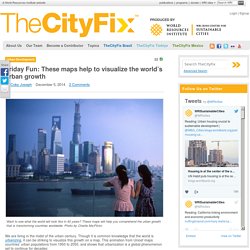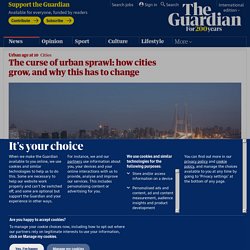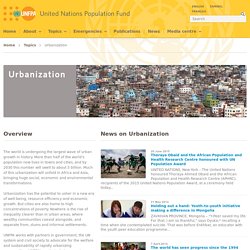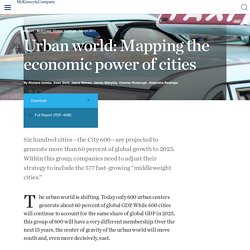

CDRC Maps. These maps help to visualize the world’s urban growth. Want to see what the world will look like in 40 years?

These maps will help you comprehend the urban growth that is transforming countries worldwide. Photo by Charlie Ma/Flickr. We are living in the midst of the urban century. Though it is common knowledge that the world is urbanizing, it can be striking to visualize this growth on a map. This animation from Unicef maps countries’ urban populations from 1950 to 2050, and shows that urbanization is a global phenomenon set to continue for decades: Graphic by Unicef.
As seen in the animation, a number of African countries will go from less than 25% urban in 1950 to more than 75% urban in 2050. Image by Valerie Pieris. Asian countries are undergoing a century-long rural to urban migration. Bright lights, big cities. The curse of urban sprawl: how cities grow, and why this has to change. I have just spent two days in Barcelona, one of the most densely populated urban settlements in the world.

There are 103 road intersections per sq km – high compared to Brasilia’s 41 or Shanghai’s Pudong area, which has only 17. Yet despite these high densities, residents of Barcelona will tell you how profoundly liveable their city is. Visitors are charmed by the pedestrianised streets that thread their way through a maze of buildings constructed over the centuries – between four and seven storeys high, on narrow streets leading to piazzas where people sit at cafe tables or under shady trees. Many residents walk or cycle to work, and public transport functions very well. Top 20 megacities by population - About us. Urbanization. An urbanizing world Today, population growth largely means urban population growth.

World’s population increasingly urban with more than half living in urban areas. Urban population boom poses massive challenges for Africa and Asia. Two-thirds of the world's population will live in cities by 2050, posing unique infrastructural challenges for African and Asian countries, where 90% of the growth is predicted to take place.

The planet's urban population – which overtook the number of rural residents in 2010 – is likely to rise by about 2.5 billion to more than 6 billion people in less than 40 years, according to a UN report. Africa and Asia "will face numerous challenges in meeting the needs of their growing urban populations, including for housing, infrastructure, transportation, energy and employment, as well as for basic services such as education and healthcare", it adds.
Future development targets should focus on creating inclusive cities with adequate infrastructure and services for all residents, said John Wilmoth, director of the UN's population division. Urban Population Map. Close Source United Nations, Department of Economic and Social Affairs (UNDESA), Population Division special updated estimates of urban population as of October 2011, consistent with World Population Prospects: The 2010 revision and World Urbanization Prospects: The 2009 revision.

Graphic presentation of data based on The Guardian, 27 July 2007. This map is stylized and based on an approximate scale. It does not reflect a position by UNICEF on the legal status of any country or territory or the delimitation of any frontiers. Notes. The century of the city: top eight new megacities by 2025. A brilliant new feature by the folks at Nature explains why this century is for the city.

Called "The Century of the City," the feature outlines what's going on around the world -- and how it impacts the work of scientists and others. The feature is full of wonderful infographics, but also contains some starting facts. Among them: The United States is one of the few developed countries where cities continue to grow. Its urban population is predicted to increase by 15 percent to reach 308 million in 2025.Most urban growth in the U.S. isn't happening in big metro areas -- though New York City is predicted to reach 20.1 million people by 2025 -- but in smaller cities with less than a million people.Europe is stagnating. Cities: The century of the city. The growth of megacities. Megacities, not nations, are the world’s dominant, enduring social structures — Quartz.
Back in June, NASA tested a booster for the most powerful rocket it has ever tried to build, the Space Launch System (SLS).

The booster alone was more than 150 feet long, producing 3.6 million pounds of force, and reaching temperatures of nearly 6,000°F during a ground test in Promontory, Utah. The whole rocket is so expensive it will probably only fly twice in the next four years, if at all. A month later, in the Mojave Desert, a very different test took place, involving a prototype rocket just 12 feet long. Built by a small company called Vector Space, it flew just a few thousand feet in the air, successfully demonstrating 3-D printed engine parts that will plug into a full-scale version just 42 feet long, not even a third of the size of one of SLS booster. Megacity life. Urban world: Mapping the economic power of cities. Six hundred cities—the City 600—are projected to generate more than 60 percent of global growth to 2025.

Within this group, companies need to adjust their strategy to include the 577 fast-growing “middleweight cities.”